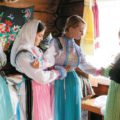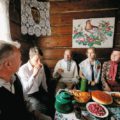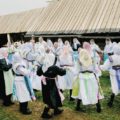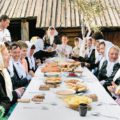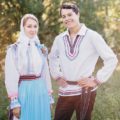Mountain Mari are a sub-ethnic group of the small Finno-Ugric Mari people. Most of the mountain Mari live on the land of their ancestors in the mountainous regions of the Republic of Mari-El, located in the center of the European part of Russia. Many interesting and distinctive rituals have survived to this day in the traditional culture of this ancient people, one of which is marriage ceremony.
Hill Mari wedding involves a spectacular traditional complex of rituals. It can be divided into three main stages: matchmaking, marriage, and post-wedding rites. The older family members oversaw marriage issues. Young men usually married at the age of 16 to 24, while the bride in the early 20th century was often 3–5 years older, because parents were in no hurry to marry off their daughters — in this case, they would stay to help around the house for longer, while families of young men were eager to marry their sons as early as possible to add another pair of working hands.
The bride was chosen very carefully. Marriages between relatives up to the seventh generation were forbidden. The girl’s family, their financial standing and reputation were of great importance. When a young man wanted to marry, he first sought permission from his parents, then went to the village where his future fiancé lived. He then informed the girl of his intentions through a relative.
Bride-show
The bride-show among Hill Mari usually featured two matchmakers of opposite sex, the person who selected the future bride, the groom’s father and the groom himself. All participants had to come on horseback or in a cart, even if the bride lived a couple houses away. The bride-show involved eating ritual food served in a special leather bag made from the skin of a sacrificial animal.
Offer of marriage
The offer of marriage involved sponsor father, groom’s father, matchmakers and the groom. The groom’s father brought flatbread with butter. During the marriage offer, the final decision about the wedding had to be made with consecration of the marriage contract. Before the groom arrived, the bride’s father put a loaf of bread on the table and a dish with melted butter. Then the bride’s parents were asked whether they agree to marry off their daughter. They were not supposed to agree immediately — the matchmakers had to be persistent.
The offer of marriage was accompanied by gift giving, which indicated a favourable outcome of the matchmaking. As a sign of consent, the Hill Mari bride gave the groom a towel or canvas that he would tie over his shoulder. At that stage, a home engagement took place in the form of ring exchange. Then the parents agreed on the size of the bridewealth and the date of the wedding.
The bride packed her chest after bathing and before the arrival of the wedding procession. The bride’s friends and her godmother were also present. Before packing, the godmother and the bride’s parents threw hops, grain or small coins into the chest so that the girl would always live in wealth. Then it was filed with the bride’s belongings, gifts to the groom’s family and a loaf of bread on top.
Wedding at bride’s house
At the wedding ceremony, each family member, each villager and agemates of the bridal couple had their own specific roles.
Before the arrival of the groom, the bride was dressed in a traditional costume consisting of embroidered dress with a caftan on top coupled with a belt and an apron. She also wore silver jewellery. The bride covered her head with a headscarf to show that she was still a girl.
Once the groom’s wedding procession came, the gates in the bride’s house were closed.
Groom’s friends had to get over the fence and open the gate to show their skill and courage. Meanwhile the bride was being hidden, and the groom was to prove his ingenuity by finding her.
During the feast at the bride’s house, the groom sat in a special place covered with felt, with his father and close relatives next to him. One of the distinctive features of the Hill Mari wedding rite is arranging a specific wedding venue, the shylyk. A rowan-tree was put in the courtyard together with several tables with benches for treating guests and the wedding master.
The guests did not stay long at the bride’s house. After having some good time, the wedding procession started heading towards the groom’s place. The groom’s friends carried the bride’s dowry into the cart, while the parents gave last instructions to their daughter such as “be humble to the elders, fear the youngers”, etc. She thanked them by giving gifts.
Wedding at groom’s house
At the groom’s house, the newlyweds were greeted by his parents with wheat butter cake. A lambskin was thrown on the ground in front of the bride and groom.
After greetings, the young people sat at a table in the storage closet and were first served scrambled eggs that they had to eat using one spoon, and then the stew. Meanwhile the wedding master along with special guests took their seats in shylyk, just like at the bride’s house. The groom’s shylyk was the site were the most significant ritual moments of the wedding took place such as introducing the bride, removing her wedding veil, prayer, treating the bride’s relatives, giving gifts to the husband’s relatives by the young wife.
At the end of the day, the groom’s friends and a female assistant made the bed for the newlyweds. They placed logs under the bed as a fertility ritual. The groom had to be quick, otherwise his friends could jump into bed ahead of the bride. The groom had to be first in everything: the first to step over the doorstep, the first to pass, the first to start eating with a spoon — only then he would become a true head of household.
Wedding at groom’s house. Day 2
The next day, the bride was first shown the way to the nearest spring. This ritual was aimed at introducing the young wife to her husband’s kin. The girl would throw a coin into the water as a sacrifice to the water goddess. The young wife used the water from the spring to prepare a meal, which she would then serve to all guests.
An interesting part of the wedding ceremony was the ceremonial viewing of the bride’s dowry, followed by gift giving and appreciation of the bride’s skill.
After treating all the guests, the bride and groom would dance the osh patya (“white hogg”) dance. As the young couple danced, guests would throw money on the floor, both coins and notes, and then pieces of canvas or handkerchiefs over the cash.
A church wedding could happen as part of the traditional ceremony or the next week.
Post-wedding
The post-wedding rites of Hill Mari involve mutual visits by the two families and rituals of avoidance. The young woman could visit her parents for the first time only with her husband. The first trip of the newlyweds to the wife’s parental home was of great importance. For the first time ever, the parents and relatives saw her in a female headdress, meaning that she was now a married woman. This visit took place three days after the wedding and was called the “sharpan feast”. The young husband along with his parents and new wife visited his father-in-law and brought beer and butter cakes as treats.
Virginity test rituals took place during the post-wedding visit of the young people to her parents. Special course of scrambled eggs was served, and if the son-in-law started eating it carefully from the edge, this meant that the bride was innocent; otherwise he would begin from the middle and turn his spoon over. Another option was presenting silver coins to the mother-in-law as a token of gratitude.
Rituals of avoidance are another important element in the post-wedding period. The young woman could not appear without a headdress and barefoot in the presence of older relatives.
The taboos observed during the wedding ceremony were designed to ensure a happy future for a young family, to facilitate the transition of the bride from one family to another.
The second visit of the young family to the wife’s parents took place in the fall, after harvest. This visit was mandatory, and feasting lasted for 24 hours. The next obligatory visit took place in the winter, when the couple went to the wife’s father alone with some wine to receive the cattle that was promised as a wedding gift. After some time, the wife’s parents would pay a return visit to the young people’s home where they would also spend a day.
During the traditional wedding ceremony, young people acquired practical and theoretical knowledge about married life.
Denis Knyazev,
Weddings of the World: Cultural Heritage project
Viktoria Belevtsova,
Ph.D in History, scholar of Mari wedding rites

